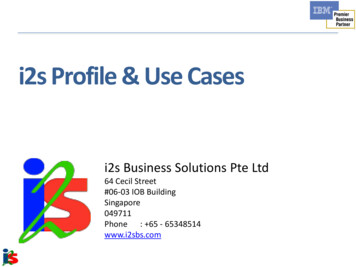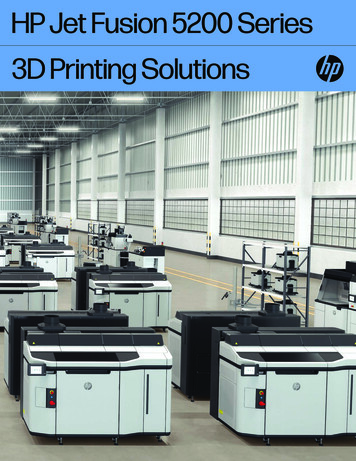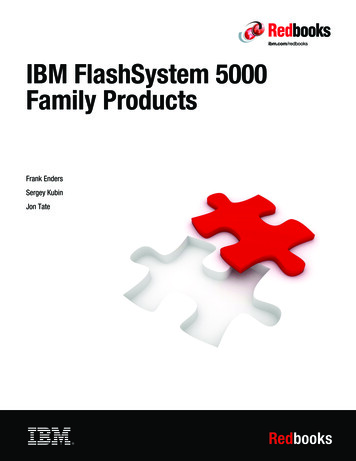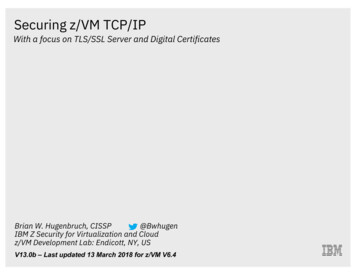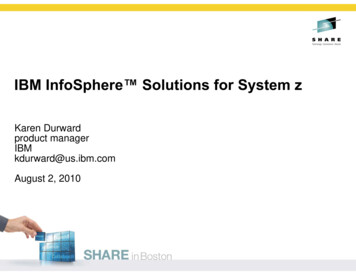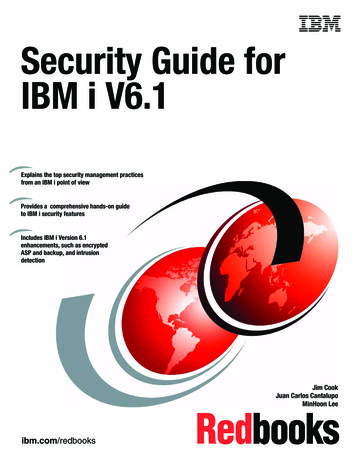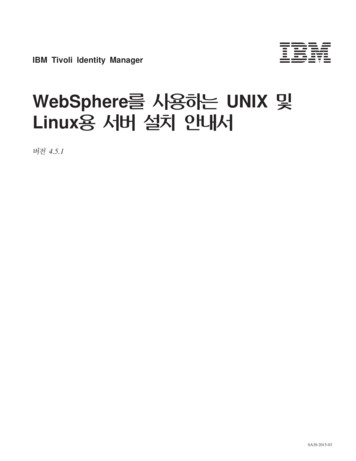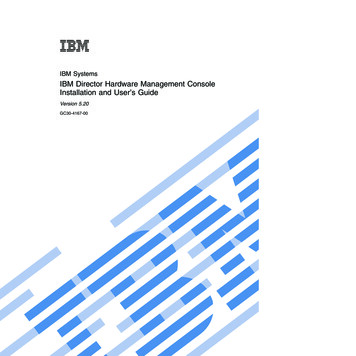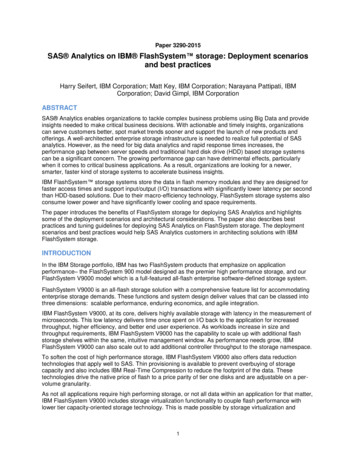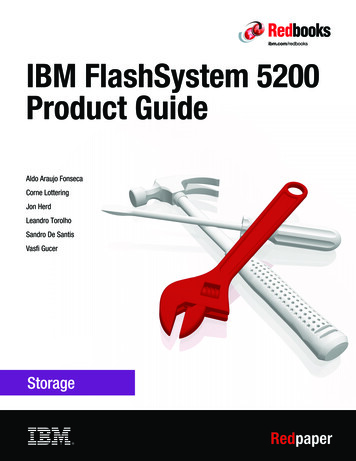
Transcription
Front coverIBM FlashSystem 5200Product GuideAldo Araujo FonsecaCorne LotteringJon HerdLeandro TorolhoSandro De SantisVasfi GucerRedpaper
IBM FlashSystem 5200 Product GuideThis IBM Redbooks Product Guide publication describes the IBM FlashSystem 5200solution, which is a next-generation IBM FlashSystem control enclosure. It is an NVMeend-to-end platform that is targeted at the entry and midrange market and delivers the fullcapabilities of IBM FlashCore technology.It also provides a rich set of software-defined storage (SDS) features that are delivered byIBM Spectrum Virtualize, including the following features: Data reduction and deduplicationDynamic tieringThin provisioningSnapshotsCloningReplicationData copy servicesTransparent Cloud TieringIBM HyperSwap including 3-site replication for high availability (HA)Scale-out and scale-up configurations further enhance capacity and throughput for betteravailability.The IBM FlashSystem 5200 is a high-performance storage solution that is based on arevolutionary 1U form factor. It consists of 12 NVMe Flash Devices in a 1U storage enclosuredrawer with full redundant canister components and no single point of failure.It is designed for businesses of all sizes, including small, remote, branch offices and regionalclients. It is a smarter, self-optimizing solution that requires less management, which enablesorganizations to overcome their storage challenges.Flash has come of age and price point reductions mean that lower parts of the storage marketare seeing the value of moving over to flash and NVMe-based solutions. The IBMFlashSystem 5200 advances this transition by providing incredibly dense tiers of flash in amore affordable package. With the benefit of IBM FlashCore Module compression and newQLC flash-based technology becoming available, a compelling argument exists to move awayfrom Nearline SAS storage and on to NVMe.With the release of IBM FlashSystem 5200 Software V8.4, extra functions and features areavailable, including support for new Distributed RAID1 (DRAID1) features, GUIenhancements, Redirect-on-write for Data Reduction Pool (DRP) snapshots, and 3-sitereplication capabilities. Copyright IBM Corp. 2021. All rights reserved.ibm.com/redbooks1
Flash for less than the cost of diskIntegral to the IBM FlashSystem 5200 solution is the IBM FlashCore technology. The recentevolution of this technology saw the introduction of inline hardware compression anddecompression.The IBM FlashSystem 5200 system with IBM FlashCore Modules NVMe type drives featuresbuilt-in hardware data compression as standard, and this data reduction is “always on”. Thiscompression is implemented in hardware by using field-programmable gate arrays (FPGAs)within each module and a modified dynamic GZIP algorithm. With this approach, the solutioncan deliver the level of performance that you expect without compression, with the addedbenefit of better use of the physical storage.Compression and decompression do not affect the performance. It also scales linearly withthe number of instances; that is, performance depends on the number of instances, notwhether compression is used.In addition, IBM FlashSystem 5200 control enclosure supports DRP compression anddeduplication that can increase the effective capacity of your flash storage up to 5x, whichdecreases the cost for effective capacity up to 80%.DRPs support active data, unlike other data reduction solutions. The IBM FlashSystem 5200control enclosure offers several features benefiting DRP compression workloads. Thesefeatures include eight Intel core processors with up to 256 GB of memory per node, and abuilt-in compression accelerator for hardware-assisted compression. In addition, the IBMFlashSystem 5200 system with IBM FlashCore Modules NVMe-type drives appliescompression to any data that is not compressed.The IBM FlashSystem 5200 system also supports the new Storage Class Memory (SCM)type drives. SCM is a new storage media technology that offers high endurance, high IOPS,and ultra-low latencies.For more information, see “Storage Class Memory” on page 14.Agile integrationThe IBM FlashSystem 5200 system features the following agile characteristics: Fully integrated system management Application-aware data services Advanced Encryption Standard (AES), data at rest encryption with all NVMe type drives,SAS drives, and IBM FlashCore Modules drives with FIPS 140-2 Inline hardware compression with IBM FlashCore Module type drives External storage virtualization Tiering or mirroring to existing cloud storage Mixed workload consolidation Nondisruptive data migrations Concurrent code load2IBM FlashSystem 5200 Product Guide
By accelerating physical and virtual applications, the IBM FlashSystem 5200 system can helporganizations reduce costs, increase revenue, and improve customer satisfaction for all typesof applications, including the following categories: TransactionalEnterprise resource planning (ERP) and supply chain managementBig data and analyticsServer and desktop virtualizationEdge computingCloud NativeHybrid and Multi-CloudAI-empoweredThe IBM FlashSystem 5200 system includes the following AI-empowered characteristics: AI-based data placement for optimal data center performance and zero-downtime datamigration. IBM Storage Insight , which include AI-empowered predictive analytics, storage resourcemanagement, and a support platform that is delivered over the cloud.Multicloud enabledWith IBM Spectrum Virtualize on-premises, IBM Spectrum Virtualize for Public Cloud V8.4can enable clients to migrate data to and from supported public cloud providers, includingIBM Cloud and Amazon Web Services (AWS). Clients can create hybrid multicloud solutionsfor their traditional block data and workloads by using built-in IP replication capabilities; forexample, implement Disaster Recovery strategies between on-premises and cloud datacenters or between cloud data centers.IBM Spectrum Virtualize for Public Cloud is deployed on a cloud infrastructure as a service(IaaS) from IBM Cloud or AWS on bare metal servers in IBM Cloud or on Amazon ElasticCompute Cloud (Amazon EC2) instances on AWS, and virtualized AWS Amazon ElasticBlock Store (EBS) storage. This setup enables clients to create clustered configurations, suchas on-premises while bringing the optimization and virtualization capabilities of IBM SpectrumVirtualize to public cloud infrastructures. These capabilities include most of the key features ofIBM Spectrum Virtualize, such as the following features: IBM FlashCopy Transparent Cloud TieringThin provisioningGlobal MirrorMetro MirrorGlobal Mirror with change volumesIBM Easy Tier to public cloud IaaSIBM Spectrum Virtualize on-premises and IBM Spectrum Virtualize for Public Cloud togetherenable a hybrid multicloud deployment with a single data management layer betweenon-premises systems and the cloud across heterogeneous storage pools that might exist inthe data center. IBM Spectrum Virtualize provides the following functions: Storage pooling and automated allocation with thin provisioning Easy Tier automated tiering Copyright IBM Corp. 2021. All rights reserved.3
Deduplication and compression to reduce cloud storage costs FlashCopy and remote mirror for local snapshots and remote replication Support for virtualized and containerized server environments IBM PowerVM Red Hat OpenShiftCRI-OKubernetesFor more information about IBM FlashSystem systems and Hybrid Multicloud, see IBMFlashSystem and Hybrid Multicloud.IBM FlashSystem 5200 Advanced Data ServicesThe IBM FlashSystem 5200 system provides these advanced data services: Business continuity with replication servicesData Protection with IBM FlashCopy servicesHigher storage efficiency with thin provisioningDRPs that provide compression with deduplicationIBM Easy TierExternal virtualizationIP quorum supportN Port ID Virtualization (NPIV) supportVMware vSphere Virtual Volume (VVOL) support and space-efficient copiesTransparent Cloud TieringIBM HyperSwap with remote replication (3-site replication)Clustering up to 4 x FS5200 systemsDRAID6 and DRAID1 supportRedirect on write snapshot in DRP poolsChild pool support in DRP poolsMore SCM dives supportSecurity enhancementsIBM FlashSystem 5200 enclosures overviewThe IBM FlashSystem 5200 system features the following types of enclosures: A control enclosure manages your storage systems, communicates with the host, andmanages interfaces. In addition, it can house up to 12 NVMe-capable flash drives. Thesedrives can be industry standard NVMe types or the exclusive IBM FlashCore Module(FCM) NVMe type and up to 12 optional Storage Class Memory (SCM) type drives. An expansion enclosure increases the available capacity of an IBM FlashSystem 5200cluster. It communicates with the control enclosure through a dual pair of 12 Gbpsserial-attached SCSI (SAS) connections. This enclosure can house many of the flash(solid-state drive (SSD)) and HDD type SAS type drives, depending on which model ofenclosure is ordered.4IBM FlashSystem 5200 Product Guide
Figure 1 shows the IBM FlashSystem 5200 control enclosure front and 3/4 ISO view. In thefront view, you can see the 12 NVMe drives in two rows of six drives.Figure 1 IBM FlashSystem 5200 control enclosure showing the front and 3/4 ISO viewControl enclosuresEach control enclosure can have multiple attached expansion enclosures, which expand theavailable capacity of the entire system. The IBM FlashSystem 5200 solution supports up tofour control enclosures and up to two chains of SAS expansion enclosures per controlenclosure.The IBM FlashSystem 5200 control enclosure supports up to 12 NVMe-capable flash drivesin a 1U high form factor and consists of the following machine types and models: 4662-6H2 - IBM FlashSystem 5200 control enclosure 4662-UH6 - IBM FlashSystem 5200 control enclosure utility modelNote: The 4662 UH6 model is an IBM FlashSystem 5200 solution with a 1-year warranty,and is a 4662 offered in the Storage Utility Offering space. This model is physically andfunctionally identical to the IBM FlashSystem 4662 6H2 model, except for targetconfigurations and variable capacity billing.The variable capacity billing uses IBM Spectrum control or IBM Storage Insights to monitorthe system usage, which allows allocated storage usage above a base subscription rate tobe billed per terabyte per month. Allocated storage is identified as storage that is allocatedto a specific host (and unusable to other hosts), whether data is written. Forthin-provisioning, the data that is written is considered used. For thick-provisioning, thetotal allocated volume space is considered used. Copyright IBM Corp. 2021. All rights reserved.5
Expansion enclosuresThe IBM FlashSystem 5200 expansion enclosures consists of the following machine typesand models: 4662 models 12G, 24G, and 92G.The new SAS-based small form factor (SFF) and large form factor (LFF) expansionenclosures support flash and HDD MDisks in a storage pool, which can be used for IBM EasyTier. Consider the following points: IBM FlashSystem 5200 LFF expansion enclosure model 12G offers drive options with upto 12 3.5-inch HDD or SSD flash drives. Up to 240 drives in 20 12G SAS expansionenclosures are supported per IBM FlashSystem 5200 control enclosure. The 12Gexpansion enclosure is 2U high. IBM FlashSystem 5200 SFF expansion enclosure model 24G offers drive options with upto 24 2.5-inch HDD or SSD flash drives. Up to 480 drives in 20 24G SAS expansionenclosures are supported per IBM FlashSystem 5200 control enclosure. The 24Gexpansion enclosure is 2U high. IBM FlashSystem 5200 LFF expansion enclosure model 92G offers drive options with upto 92 3.5-inch (and 2.5-inch drives in carriers) HDD and SSD flash drives. Up to 784 drivesin eight 92G SAS expansion enclosures are supported per IBM FlashSystem 5200 controlenclosure. The 92G expansion enclosure is 5U high.Note: The maximum limit of storage that can be managed by the FS5200 is still 32 PB.With higher density drives, this limit might be reached sooner; therefore, measurementsmust be considered to observe storage consumption.The IBM FlashSystem 5200 control enclosure can be recognized by the nomenclatureon the left and side snap catch cover, which covers the rack-mounting screws. This labelcontains the machine type, and model and serial numbers of the IBM FlashSystem 5200control enclosure.Figure 2 on page 6 shows the IBM FlashSystem 5200 bezel and NVMe drive description.Figure 2 IBM FlashSystem 5200 bezel and IBM FlashCore Module description6IBM FlashSystem 5200 Product Guide
Labeling on the NVMe drive provides the drive type, capacity, and FRU number. The examplethat is shown in Figure 2 on page 6 is the IBM FlashCore Module NVMe 19.2 TB type.The IBM FlashSystem 5200 expansion enclosures that are shown next show the size of therespective units and the number of drives in each (12G and 24G only).Figure 3 shows the IBM FlashSystem 5200 expansion enclosure model 12G and the 123.5-inch drives it can contain.Figure 3 IBM FlashSystem 5200 expansion enclosure model 12G front viewFigure 4 shows the IBM FlashSystem 5200 expansion enclosure model 24G and the 242.5-inch drives it can contain.Figure 4 IBM FlashSystem 5200 expansion enclosure model 24G front viewFigure 5 shows the IBM FlashSystem 5200 expansion enclosure model 92G. This enclosurecan contain up to 92 drives of 3.5-inch or 2.5-inch, in-drive carriers.Figure 5 IBM FlashSystem 5200 expansion enclosure model 92G front view Copyright IBM Corp. 2021. All rights reserved.7
Placing your IBM Flash System family storage system in yourinfrastructureThis section describes the possible use cases and where to place the FS5200 (or anothersystem belonging to the IBM Flash System family) in the client infrastructure. This kind ofsolution system can address many possible requirements and can be used to harmonize andsimplify an IT storage infrastructure.FS5200 can be used as a production data repository and a component of a DR solutionbecause a primary system can send data in an efficient way into the hybrid multicloudinfrastructure.In particular, the FS5200 system can meet the following customer requirements: First tier repository for production data. Primary or target system for data replication or disaster recovery. Provide HA services enables the HyperSwap solution with 2 FS5200s in sync replication Use Spectrum Virtualize capabilities to manage and virtualize older IBM or non-IBMstorage and extend advanced Spectrum Virtualize functions (for example, data reduction)to the external capacity presented by the old storage.Old storage systems can be decommissioned or their usage can be extended as an addedpool of resources to the Flash System. Spectrum Virtualize in FS5200 can provide the intelligent data migration tool from an outerstorage to replace it or distribute application workload on more systems FS5200 can use Transparent Cloud Tiering (TCT) to move data into the cloud:– Use IBM Spectrum Virtualize for Public Cloud on Amazon AWS or other providers.– Use the Container Storage Interface (CSI) driver for Red Hat OpenShift ContainerPlatform (which enables Cloud Pak foundation). Use IBM software-defined storage (SDS) and IBM Spectrum Suite capabilities, including:– Spectrum Scale support, because the Flash system can be used as a repository forseveral tiers in initial microprogram load (IML) processing.– IBM IBM Spectrum Protect as cache or data repository.– Spectrum Protect Plus as repository.– Copy Data Management.8IBM FlashSystem 5200 Product Guide
Figure 6 shows an IBM Flash system 5200 as the main provider of advanced data servicesfor on-premises and in a hybrid multicloud system.Figure 6 IBM Flash system 5200 as the main provider of advanced data servicesThe modern and advanced data services that are provided by a storage system should coverseveral scopes concurrently. The IBM Flash Family components (including FS5200) all sharethis main characteristic.Because all IBM FlashSystem products share the functions and software layer, it is easy toselect the suitable system that can match performance, capacity, and functionalrequirements.For example, looking at Figure 6, we can select the fundamental and modern use case withan on-premises shared storage system that is connected to older (in the primary IT location)and containerized environments. This configuration enables the remote connection to feedthe remote cloud counterpart equipped with the same software platform. This platformenables the requested extended services, such as archiving and testing.All of these capabilities are provided by the common SDS solution that is called IBMSpectrum Virtualize. Copyright IBM Corp. 2021. All rights reserved.9
This example is shown in Figure 7.Figure 7 Sample scenarioSpectrum Virtualize is included in all the IBM FlashSystem storage products (for exampleFS5200) and can be deployed in the AWS or RHEL cloud platforms.Did you know?The IBM FlashSystem 5200 system runs IBM Spectrum Virtualize V8.4.0, which provides thefollowing functions: Supports the IBM FlashCore Module NVMe type drives with IBM enhanced flashtechnology. The IBM FlashSystem 5200 control enclosure supports up to 12 ultra-low latency2.5-inch (SFF) 4.8 TB, 9.6 TB, 19.2 TB, or 38.4 TB IBM FlashCore Module NVMe types orup to 12 NVMe 800 GB, 1.92 TB, 3.84 TB, 7.68 TB, or 15.36 TB industry-standard drives,or a mixture of both. Supports up to 12 NVMe SCM Drives in capacities 375 GB, 750 GB, 800 GB, and 1.6 TB. IBM FlashCore Module NVMe types provide automatic data compression and encryptionwithout affecting the system performance. The IBM FlashSystem 5200 system can use IBM Security Key Lifecycle Manager orUSB key encryption. Up to four IBM Security Key Lifecycle Manager key servers aresupported. Offers hardware-based AES 256 data-at-rest encryption by using USB key and IBMSecurity Key Lifecycle Manager key server-based encryption, with no performance impact. RSA enables IBM support personnel to access the system to complete troubleshootingtasks.10IBM FlashSystem 5200 Product Guide
Consistency protection for Global Mirror, Metro Mirror replication, and High Availability. Management GUI support for host clusters, including private and shared volumemappings. Throttling allows customers to control resources that are used when the system isprocessing I/Os on hosts, host clusters, volumes, copy offload operations, and storagepools. TCT is a function of IBM Spectrum Virtualize that uses IBM FlashCopy mechanisms toproduce a point-in-time snapshot of the data. Provides flexible interface types, including FC and Ethernet (iWARP and RDMA overConverged Ethernet [RoCE] protocols) to easily integrate into SAN and iSCSI networkenvironments. IBM Storage Insights offers some key capabilities that help clients meet the demands thatare put on IT by helping to build the connective fabric between IBM, storage, and the user.IBM Storage Insights provides advanced customer service and monitors the performance,capacity, and health of each device. Supports DRAID1 and DRAID6 protections to provide the suitable level of reliability andperformances. The 5200 can support up to 340 TB usable or 790 TB effective in 1U. The 5200 can support the following expansion models with a SAS expansion card that isinstalled in the second adapter slot: 12G, 24G, 92G, F12, F24, F92. The expansionenclosures are reused from theV5000E/FS5000H family. Note that connecting enclosuresfrom Storwize V5000E/FS5000 to FS5200 is not supported.Current release functionsThis section describes several new functions and features that are available in the currentIBM FlashSystem 5200 release.New in IBM FlashSystem 5200 Software V8.4.0The following functions are included in IBM FlashSystem 5200 Software V8.4.0: 3-site Data Replication for HyperSwap, which supports the following use cases:– Disaster scenarios– Site maintenance– Link failure cases Security updates:– IBM is releasing a new set of options to allow a security administrator to create policiesfor passwords, account lockout, session timeout.– Create a single system-wide policy that applies to all local accounts (session timeoutsalso apply to remote accounts).– Configurable CLI timeout.– HTTP proxy server for cloud Call Home and Storage Replication Adapter (SRA) logupload.– NVME drive security updates (new events and sense data to better identify and resolveNVMe drive encryption errors) and secure data deletion. Copyright IBM Corp. 2021. All rights reserved.11
UI modernization updates:––––Modernized syslog servers window.New host dialog.New Add Storage experience.Modernized remote copy experience (2-site and 3-site). DRAID-1:– 2-member drives per array (0 rebuild area)– 3 - 16 member drives per array (1 rebuild area)– System recommendation is to create DRAID-1 in arrays up to six drives Data reduction child pools:– User can create child pools in data reduction parent pools.– Data reduction child pools are created without a quota and can use entire parentcapacity. DRP:– Redirect-on-write for DRP snapshots adds a redirect-on-write (RoW) alternative to thecopy-on-write (CoW) capabilities.– Comprestimator always on.– RAID Reconstruct Read (3R), which uses RAID capabilities, asks DRP for a specificdata block reconstruction when detecting a potential corruption. Miscellaneous:– Updates to maximum configuration limits.– 8.4.0 mirrored VDisk fast format enhancements.– 8.4.0 FC-NVMe enhancements.– 8.4.0 improved handling of memory errors.– SCM restrictions lifted. For more information, see “Storage Class Memory” on page 14.– As of Spectrum Virtualize 8.3.1.2 and SI/ Spectrum Control 5.3.7 or later, datacollection can be done with Monitor (least privileged) role. As each node writes astatistics file, it automatically is uploaded to the configuration node.– 8.4.0 DNS support enhancements.IBM FlashCore technologyAt the heart of the IBM FlashSystem 5200 system is IBM FlashCore technology (if the IBMFlashCore Module NVMe type drives are ordered), which consists of the followingkey elements: Hardware-accelerated architecture that is engineered for flash, with a hardware-only datapath. The IBM FlashSystem data compression and decompression algorithm is a Modifieddynamic GZIP algorithm. It is implemented completely in hardware; no processorintervention is required. IBM FlashCore Modules, which are designed for low latency, density, and reliability. IBM Advanced Flash Management, which improves flash endurance over standardimplementations without sacrificing latency.12IBM FlashSystem 5200 Product Guide
Figure 8 shows IBM FlashCore technology.Figure 8 IBM FlashCore technologyIBM released the second generation of FlashCore Modules (FCMs). The innovative design ofthese custom-designed modules delivers improved performance, capacity, and reliability.Clients can experience latency as low as 70 microseconds, which helps remove bottlenecksin their workloads. The outstanding performance of FCMs includes data reduction that isobtained from embedded hardware. Data reduction occurs as fast as data can be written tothe modules.Capacity takes a step forward with a new 38.4 TB module. Although that capacity soundsimpressive, it does not really tell the whole story. Because each FCM delivers wire-speedcompression and IBM provides a 2-to-1 compression guarantee, clients obtain 76.8 TB in a2.5-inch small form factor device. Therefore, clients can see 790 TB of effective raw capacityin only 1U of space and do that without affecting performance.A less obvious benefit of the FCMs is greatly enhanced flash endurance. Many factors helpdeliver up to 7 x greater flash endurance than an industry-standard, commoditysolid-state-drive (SSD), which translates to fewer issues for clients. It also means that timedoes not have to be spent dealing with failing SSDs and drive rebuilds.For more information about IBM FlashCore technology, see What is flash storage?. Copyright IBM Corp. 2021. All rights reserved.13
Storage Class MemorySCM is an industry-wide standard definition for non-volatile memory devices that performfaster ( 10µs) than traditional NAND SSDs (100µs), but slower than dynamic random accessmemory (DRAM); 100 ns.The technology pricing sits between DRAM and traditional NAND. Price is significantly moreexpensive than traditional NAND drives.At the time of this writing, the following vendors are most prevalent in the marketplace: Intel (3D Xpoint memory technology in Optane drives) Samsung (zNAND memory technology in zSSDs)The IBM FlashSystem 5200 system supports the new low-latency, high-speed SCM drives inany of the slots of the control enclosure. The drives are inserted into the control enclosurefrom right to left, bottom row to top row. The control enclosure can contain up to 12 SCMdrives (which completely populates the control enclosure).Figure 9 shows the SCM drive locations in the IBM FlashSystem 5200 control enclosure. TheSCM Drives are populated in reverse slot order (slots 12 - 7, then slots 6 - 1).Upper Drive Slot Locations (Plug Sequence #2)123456789101112Lower Drive Slot Locations (Plug Sequence #1)Figure 9 SCM Drive locations slotsSCM and Easy TierBecause of their faster speed, SCM drives are placed in a new top tier of Easy Tier. This newtier is ranked higher than the tier0 flash that is used for NVMe NAND drives that aresupported today. Easy tier features the following levels: Storage Class MemoryStorage Class Memory tier exists when the pool contains drives that use persistentmemory technologies that improve endurance and speed of current flash storage devicetechnologies. Tier 0 flashTier 0 flash tier exists when the pool contains high-performance flash drives. Tier 1 flashTier 1 flash tier exists when the pool contains tier 1 flash drives. Tier 1 flash drives typicallyoffer larger capacities, but slightly lower performance and write endurance characteristics. Enterprise tierEnterprise tier exists when the pool contains enterprise-class MDisks, which are diskdrives that are optimized for performance.14IBM FlashSystem 5200 Product Guide
Nearline tierNearline tier exists when the pool contains nearline-class MDisks, which are disk drivesthat are optimized for capacity.Hot data is placed in the SCM tier when Easy Tier is enabled. DRP and VG extent allocationwas tuned to use SCM drives, specially for metadata (directory volume lookups). Thisexample is one of the main use cases for SCM drives in an IBM FlashSystem 5200 system.SCM and RAID configurationsSCM drives feature the following rules regarding RAID supported configurations: Distributed DRAID 1 with two drives (including distributed spare capacity) or more and isthe best practice recommendation and configuration. Distributed DRAID 5 with four drives (including distributed spare capacity) or more issupported. Distributed DRAID 6 with six drives (including distributed spare capacity) or more issupported. Traditional TRAID 1 and 10 with two drives is supported; however, no spare is available,and performance might be limited. SCM drives have their own SCM technology type and drive class. SCM and Standard NVMe (or SAS) cannot intermix in the same array. Easy Tier tier scm arrays can take lower tech types as spare drives when no tier scmdrives are available. Lower tier arrays can accept tier scm drives as superior drives.SCM drive formatting and UNMAPSBecause of its media technology, SCM drive formats take much longer to format a drive thana typical NVMe drive. The drive formats can take up to 15 minutes; therefore, the user mustbe patient and wait until the process completes.SCM drive formats occur when one of the following conditions exist: A drive is replaced.An enclosure is managed.An array or MDisk is removed.Note: Intel Optane drives do not support UNMAPs because it is not beneficial for thesedrives. Instead, the system writes zeros to deallocate drive sectors.IBM Storage Expert Care Service and Support optionsThe IBM FlashSystem 5200 system announces with a new set of IBM Storage Expert CareService and Support options. These options provide new levels (and a matrix), of servicecover, with the options of 1 - 5 years duration.Base warrantyThe IBM FlashSystem 5200 models 6H2 and UH6 control enclosures are sold with aone-year, parts-only warranty at the point of ordering. The customer must then choosebetween the Silver or Gold services offering and also the duration of the contract, which canbe 1 - 5 years. Copyright IBM Corp. 2021. All rights reserved.15
This level of one-year, parts-only base warranty also applies to the IBM FlashSystem 5200models 12G, 24G, and 92G expansion enclosures. These enclosures also must have thesame service level offering applied to them as the IBM FlashSystem 5200 control enclosureto which they are going to be attached at the point of the initial order.Note: The duration of the contract for these expansion enclosures does not have to be thesame as the control enclosure. This flexibility gives the customer the ability to choose thelength of service cover they require.Service and support levelsThe following warranty and service levels available for the IBM FlashSystem 5200 with IBMStorage Expert Care service and support:Note: The following keys terms are used in this list: CRU: Customer Replaceable UnitNBD: Next Business DaySBD: Same Business DayLMC: Licensed Machine Code24/7/4: 24 Hours per day/7 days a week/4-hour response9x5: 9 hrs per day, Monday - Friday only (no weekends or public holidays). Base warranty:– Parts Only– HW CRU (9x5 available as exception)– Remote Technical Support included (HW only) Basic:––––––9x5, NBDHW CRU (9x5 available as exception)SW/LMC Subscription and SupportStorage Insights basic (ticket opening)Remote Technical Support (HW and SW)Client or Business Partner
IBM Cloud and Amazon Web Services (AWS). Clients can create hybrid multicloud solutions for their traditional block data and workloads by using built-in IP replication capabilities; for example, implement Disaster Recovery strategies between on-premises and cloud data centers or between cloud data centers.

